The graduation projects of young artists Anca Zaharov and Robert Băjenaru (BA) and Cristian Emil Ghiță (MA) are noted for the dynamic dialogue between materials and textures and for the openness towards current contemporary topics. Anca uses the technique of molding to clone realistic lower limbs in her research of the various positions that can cause anxiety for motor activity, amplified from last century. Cristian issues relevant demonstrations regarding three-dimensional drawing, and Robert’s Greenhouse does not include ordinary plants, but artificial plants, as synthetic as can be. It reminds one of the cult of artificiality praised by modern poets and decadent writers, but within a form that is logically framed to be a theme of current interest, intended precisely to save all that is natural.
Anca Zaharov presented her work Fragile, coordinated by Aurel Vlad, an installation composed of wax figures, separated into three groups. They naturally distance themselves through the added thorns, while at the same time, seemingly appearing close together, thus producing a curious fascination with the viewer. The figures remind of the contorted figures, hybrids and old monsters found on the margins of the pages of medieval manuscripts, evoking “a fascinated start that leads me toward and separates me from them” (Julia Kristeva, Powers of Horror). The hybrid figure in Anca Zaharov’s work is half human, half vegetable, made from wax, simulating meat and covered by a layer of three types of natural thorns, incorporating in its duality the two central principles in the artist’s work. If this antithesis is expressed by the choice of materials themselves, their reconciliation through the artistic process acts on the figure as an anesthetic that paralyzes sensitivity, thus commenting on human fragility. Humans are accustomed to hiding their wounds; this fragility is both stone hard as well as deformed by the violent effects of an apparent protection. The fragility embodied by wax represents a place for all possibilities, while also undoubtedly illustrating weakness: the molten wax melting under heat demonstrates the freshness of the being – as Stalker says in Tarkovsky’s film. In this case, the thorns added “with a hot nail […] on legs”, rather evokes a place of no possibilities other than the thorns’ aggressiveness as it invades the space with its mere presence, the repercussions of this act seen in the unnatural and dramatic positions of the figures.
Coordinated by Csapo Reka Dup, one year later than he should have presented his bachelor project (now complete and on view at Cazul 101) due to an unmarked anatomy exam, the artist Robert Băjenaru showcases a new work this year which, unfortunately, is also not officially accepted because of a rejected P.A. discharge. Entitled Greenhouse Effect, the work is related to the one previously exhibited at Cazul 101 via the choice of materials and the concept. As the artist himself explains, it is an installation created with the use of non-biodegradable materials found in the trash which “weakens and suffocates the natural environment”.
The installation has an activist quality to it, criticizing and opening a dialogue with consumerist society, just like other artists involved in the Recycling Art movement, which is essentially political and conceptual. Architect Alejandro Aravena’s initiative as part of the Venice Bienalle in 2016 demonstrates contemporary artists’ interest when it comes to taking attitude on big environmental issues, denouncing these on the global as well as local art scene. In an act of solidarity, they research the possibilities of working with non-perishable materials, embedding in their works political messages on revealing the effects of global passivity. With Greenhouse Effect, Robert designed a space destined for rescuing items that are harmful for the environment, with the use of everyday materials like tin foil as well as subversive materials such as condoms. Separating duct tape is used to delimit the exterior space of the installation. When building his own green house, in Huysmans’ À rebours, decadent estetician Des Esseintes orders natural exotic flowers that imitate false plants as an eulogy to artificiality in Baudelaireian style. Des Esseintes’ green house is compartmentalized in a larger green house, his own home, which he decorates in order to demonstrate a spectacle of erudition. Both represent projects made for the sake of aiding the character’s psychological state. The artist’s Green house can represent both the materialization of existential, poetical impulses, as indicated by the work’s title – which sheltered and facilitated the acceleration and improvement of some internal processes, as well as an artistic project that researches the potential of materials salvaged from the dump, also called vulgars, which carry important political messages.
The exhibition What’s Next? which hosted Robert’s graduation project took place on June 27th at BCR Palace.
Artist Cristian Emil Ghiță has developed an artistic vocabulary that focuses on the concept of the line, exploring the possibilities of this primary and ubiquitous form in the history of art. Coordinated by Darie Dup, in the master’s dissertation project Tension and Suspension the artist problematizez both the concept of line and the concept of tension, “whether we refer to human, social, political, material tensions, visible or invisible, measurable or non-measurable ”, as he himself explains. The work is composed of six elements, three organized as a whole and three autonomous, in which the central elements are coordinated on a scale of tensions: from concrete to organic leather.
Regarding the line concept, the artist refers to the three-dimensional drawing and the way the line unfolds in space. This approach to the liberation of the line from the two-dimensional space has been achieved since the twentieth century by Alexander Calder, and the possibilities of this line project are still being explored. A useful example to understand Cristian’s approach: in 2017, the duo Ruiz Stephinson presented in the exhibition And And And, at Pavillon de la Muette, an installation made of neon tubes illuminated in shades of pink rose, depicting hand gestures softened by the curved line, suspended in space. Both the line and the color are imbued with discursive abilities in the intimacy of the symphonic dialogue undertaken by the hand gestures. On the contemporary artistic scene, via the three-dimensional drawing, the line breaks away from the page to infiltrate time and space – the social space and the present time – as an element of a network permanently connected to the pulse of the present time, to meet the need for the humanization of art.
The key elements of last century’s movement morphology are integrated in the innovative moves, the artist incorporating in his aesthetic various elements of minimalism and conceptualism. After the experimental steps in which the possibilities of the line routes are explored (Transcendent route, bachelor project), the artist adds found objects to the dynamic intersection of three-dimensional lines. This causes them to coexist in a relationship of forces, both conflicting and revealing, culminating in the work where a piece of organic leather is held in suspension by a frame of threaded bars that have become a personification of the conflicting territory of tensions. With this intuitive formula discovered by the artist, under the laws of mechanical physics, the line folds intuitively according to the requirements of the suspended material. It symbolically undergoes the pressures of the almost contagious organicity and humanity exerted by the suspended material. In Emil’s work, the line responds to the issue of humanization through the innovative formula demonstrated by the deep, strongly organic curved line, but also by the discursive power it still possesses (and how), evaluated in conjunction or in contrast with the suspended material.
The common denominator for the three projects would be the ways of approaching the material, as well as working with raw material, such as time itself, as Paul-Louis Renuy explains in his work La Sculpture Contemporaine. However, the works of these young artists are not just plain explorations. These are well coagulated and articulated pieces. Cristian manages to tame the line, Anca makes uses of forms of collective memory to embody the anxiety of our own times, and Robert orders chaos by his own, purifying doing, as if he were listening to the distant call of Apollinaire when it comes to creation.
The Heterogeneous art show where Anca showcased her work took place between June 24th – July 1st at Halucinarium – Triaj Creativ.
Part of Cristian’s graduation project was exhibited as part of the show trans-FORMS, during April 17th – May 5th at Mansarda Gallery in Timișoara, and the metal bars and organic leather installation was presented as part of the exhibition #sweetinternet on July 17th at The Visual Art Center Multimedia.
POSTED BY
Maria Anghel
Maria Anghel (b. 1998) is a student in the Art History and Theory department at the National University of Arts in Bucharest, and she completed an Erasmus year abroad at Bordeaux Montaigne University ...


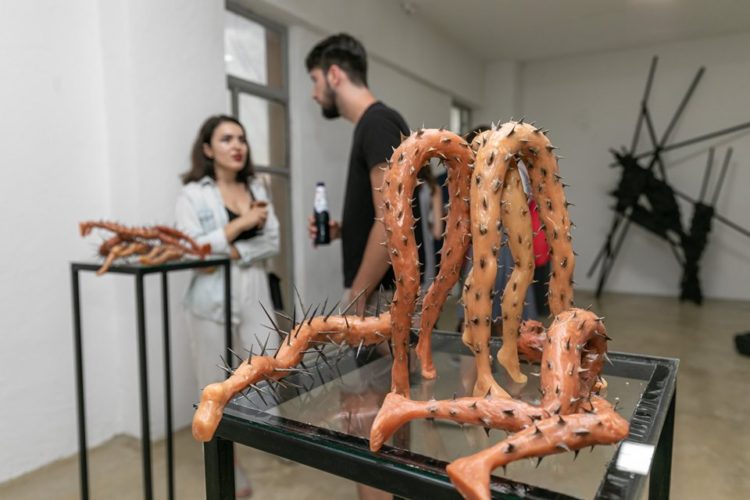
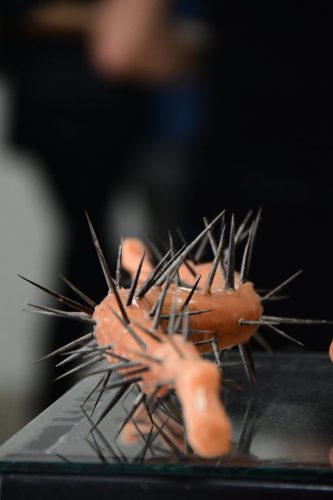
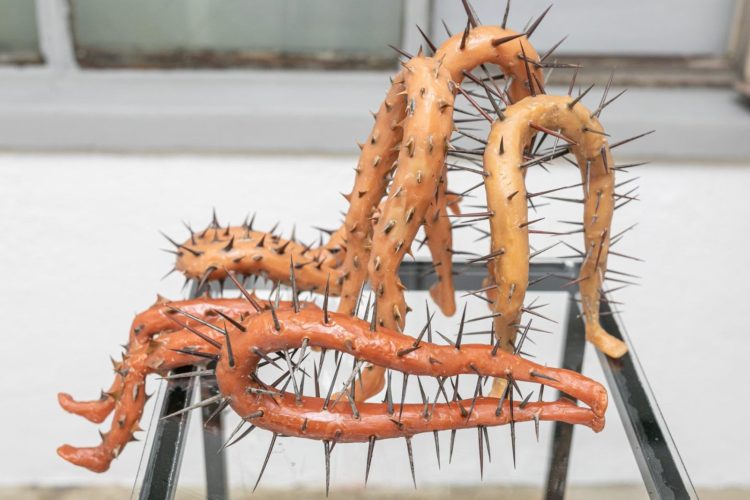
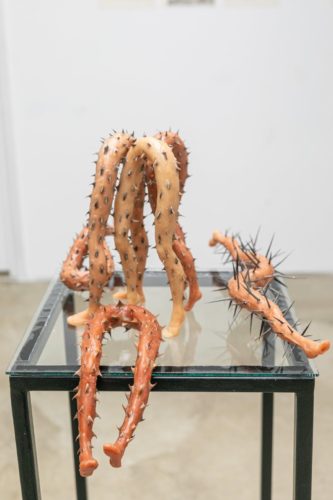
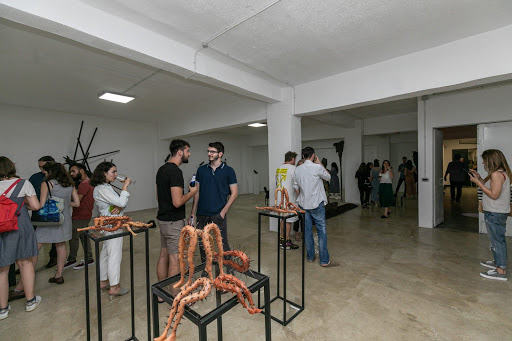
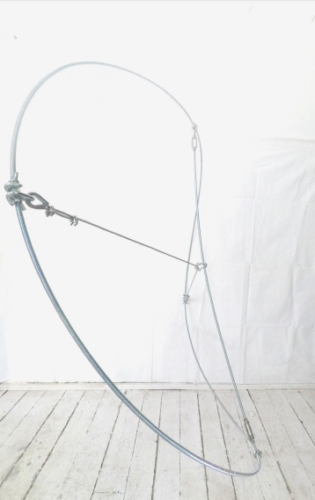
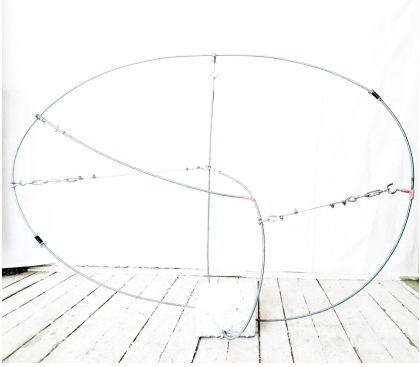
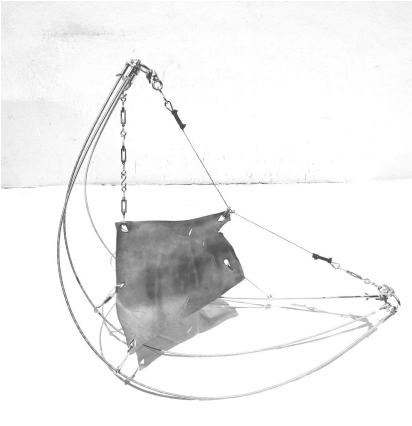
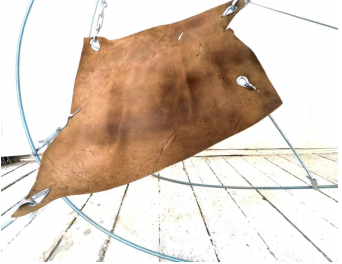
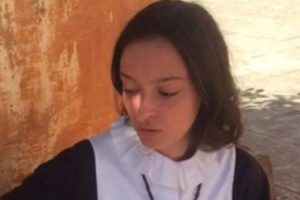
Comments are closed here.